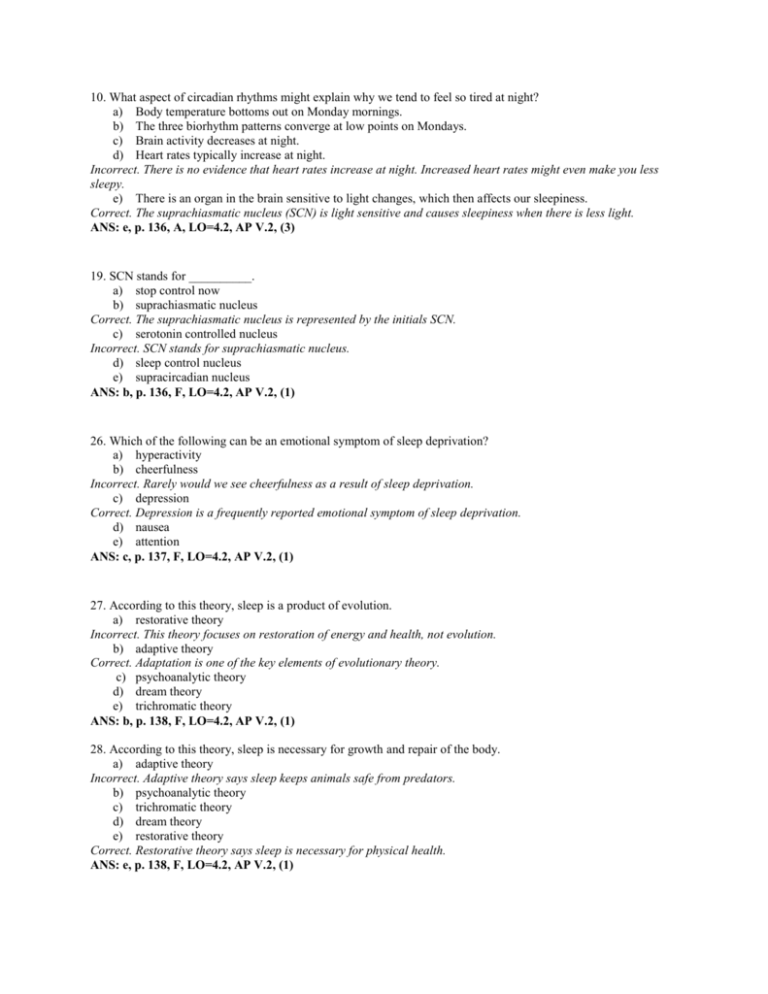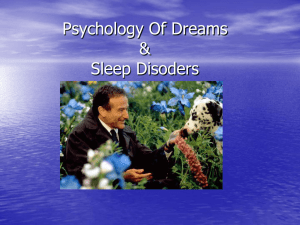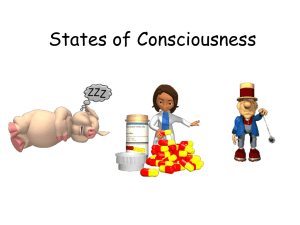10. What aspect of circadian rhythms might explain why we tend to
advertisement

10. What aspect of circadian rhythms might explain why we tend to feel so tired at night? a) Body temperature bottoms out on Monday mornings. b) The three biorhythm patterns converge at low points on Mondays. c) Brain activity decreases at night. d) Heart rates typically increase at night. Incorrect. There is no evidence that heart rates increase at night. Increased heart rates might even make you less sleepy. e) There is an organ in the brain sensitive to light changes, which then affects our sleepiness. Correct. The suprachiasmatic nucleus (SCN) is light sensitive and causes sleepiness when there is less light. ANS: e, p. 136, A, LO=4.2, AP V.2, (3) 19. SCN stands for __________. a) stop control now b) suprachiasmatic nucleus Correct. The suprachiasmatic nucleus is represented by the initials SCN. c) serotonin controlled nucleus Incorrect. SCN stands for suprachiasmatic nucleus. d) sleep control nucleus e) supracircadian nucleus ANS: b, p. 136, F, LO=4.2, AP V.2, (1) 26. Which of the following can be an emotional symptom of sleep deprivation? a) hyperactivity b) cheerfulness Incorrect. Rarely would we see cheerfulness as a result of sleep deprivation. c) depression Correct. Depression is a frequently reported emotional symptom of sleep deprivation. d) nausea e) attention ANS: c, p. 137, F, LO=4.2, AP V.2, (1) 27. According to this theory, sleep is a product of evolution. a) restorative theory Incorrect. This theory focuses on restoration of energy and health, not evolution. b) adaptive theory Correct. Adaptation is one of the key elements of evolutionary theory. c) psychoanalytic theory d) dream theory e) trichromatic theory ANS: b, p. 138, F, LO=4.2, AP V.2, (1) 28. According to this theory, sleep is necessary for growth and repair of the body. a) adaptive theory Incorrect. Adaptive theory says sleep keeps animals safe from predators. b) psychoanalytic theory c) trichromatic theory d) dream theory e) restorative theory Correct. Restorative theory says sleep is necessary for physical health. ANS: e, p. 138, F, LO=4.2, AP V.2, (1) 36. Upon just waking up, you report a vivid visual event. What term do psychologists use for such phenomena? a) hypnotic illusion b) positive hallucination c) hypnagogic hallucination Incorrect. This is related to hypnosis. d) negative hallucination e) hypnopompic image Correct. Funny name, but that’s what they call it. ANS: e, p. 141, F, LO=4.3, AP V.2, (2) 39. Sleep spindles appear during __________ sleep. a) stage 1 Incorrect. Spindles occur during stage 2. b) REM c) stage 2 Correct. Spindles occur during stage 2. d) stage 4 e) REM rebound ANS: c, p. 141, F, LO=4.3, AP V.2, (1) 40. Your brain waves are being monitored in a sleep laboratory. If you are in deep sleep less than an hour after falling asleep, what brain waves will be detected? a) beta b) alpha c) kappa d) theta Incorrect. Theta waves indicate the second deepest level of sleep. e) delta Correct. Delta waves occur in stage 4 and indicate the deepest sleep. ANS: e, p. 141, F, LO=4.3, AP V.2, (1) 41. Short, rhythmic bursts of brainwave activity that appear during stage 2 sleep are called __________. a) delta waves b) sleep spindles Correct. Sleep spindles are short, rhythmic bursts of brainwave activity. c) paradoxical sleep waves d) theta waves e) beta waves Incorrect. These waves occur when you are awake and do not have spindles. ANS: b, p. 141, F, LO=4.3, AP V.2, (1) 42. The stage of sleep in which delta waves begin to appear is __________ sleep. a) stage 1 b) stage 2 c) stage 3 Correct. Delta waves begin to appear in stage 3. d) stage 4 Incorrect. Delta waves begin to occur in stage 3. e) REM rebound ANS: c, p. 141, F, LO=4.3, AP V.2, (1) 44. The stage of sleep marked by the production of very slow delta waves is __________ sleep. a) stage 1 b) stage 2 c) stage 3 Incorrect. Stage 4 has the slowest waves. d) stage 4 Correct. Delta waves occur in stage 4 and they are the slowest waves. e) REM rebound ANS: d, p. 141, F, LO=4.3, AP V.2, (1) 46. People in stage 4 sleep __________. a) dream all the time b) are hard to wake up Correct. This sleep is very deep and waking takes time. c) are easy to wake up Incorrect. This sleep is very deep and waking takes time. d) hallucinate e) have sleep spindles ANS: b, p. 141, F, LO=4.3, AP V.2, (1) 47. Each of the following is a sleep disorder EXCEPT __________. a) narcolepsy Incorrect. This is a sleep disorder in which one falls asleep without warning. b) REM rebound Correct. This is related to lack of dreaming. c) insomnia d) night terrors e) nightmares ANS: b, p. 142, F, LO=4.3, AP V.2, (1) 48. REM myth refers to the belief that __________. a) REM sleep causes paranoia b) without REM sleep, one will go mad Correct. People deprived of REM sleep will hallucinate. c) too much REM sleep will cause one to go mad Incorrect. People deprived of REM sleep will hallucinate. d) listening to more than 8 hours of R.E.M will cause madness e) REM sleep causes hallucinations and delusions ANS: b, p. 142, F, LO=4.3, AP V.2, (1) 51. What would you expect to see on the EEG record of a person who is engaged in an episode of sleepwalking? a) paradoxical sleep waves b) very large sleep spindles Incorrect. These are not present in deep sleep, and that’s when people sleepwalk. c) evidence of deep sleep (stage 4) Correct. Sleepwalking occurs in stage 4. d) evidence of light sleep e) a record that is virtually the same as a daydreaming person ANS: c, p. 143, F, LO=4.4, AP V.2, (2) 56. REM behavior disorder results from __________. a) too much sleep b) not enough sleep Incorrect. REM behavior disorder results from the brain mechanisms blocking signals to the muscles. c) deterioration of the medial hypothalamus d) decreased numbers of theta waves e) failure of the brain mechanisms to block brain signals to the muscles Correct. REM behavior disorder results from the failure of the brain mechanisms to block signals to the muscles. ANS: e, p. 143, F, LO=4.4, AP V.2, (3) 59. Which of the following statements is TRUE? a) Night terrors are a rare disorder. Correct. Night terrors are a rare disorder. b) Nightmares, but not night terrors, suggest some psychological problems. c) Night terrors, but not nightmares, suggest some psychological problems. d) Both nightmares and night terrors suggest psychological problems. Incorrect. Neither of these sleep problems is associated with other problems. e) Night terrors occur frequently. ANS: a, p. 143, F, LO=4.4, AP V.2, (2) 85. What two categories of dream content did Sigmund Freud describe? a) poetic and realistic b) literal and symbolic c) latent and manifest Correct. Freud developed these categories of latent and manifest content. d) delusional and hallucinatory Incorrect. Freud did not think dreams were delusions or hallucinations. He thought they were symbolic. e) figurative and symbolic ANS: c, p. 148, F, LO=4.5, AP V.2, (1) 84. Freud’s psychoanalytic theory of dreaming states that __________. a) the purpose of dreaming is to express unconscious wishes, thoughts, and conflicts Correct. Freud said dreams were the fulfillment of wishes. b) there is no purpose to dreaming; dreams occur because of random brain stem signals Incorrect. Freud said dreams were the fulfillment of wishes. c) the purpose of dreaming is to resolve current concerns and problems d) dreaming is a byproduct of a process of eliminating or strengthening neural connections e) the purpose of dreaming is to reduce the probability of conscious aggression ANS: a, p. 148, F, LO=4.5, AP V.2, (1) 95. According to the activation-synthesis theory of dreaming, the source of a dream is neuronal firing in the __________. a) Broca’s area b) cortex Incorrect. Activation-synthesis hypothesis suggests that dreams are the result of the cortex making sense of signals from the brain stem. c) brain stem Correct. Activation-synthesis hypothesis suggests that dreams are the result of the cortex making sense of signals from the brain stem. d) optical lobe e) parietal lobe ANS: c, p. 149, F, LO=4.5, AP V.2, (1) 99. The activation-information-mode model suggests __________. a) events that occur during waking hours may influence dreams Correct. This model suggests that events that occur during waking hours may influence dreams. b) nothing influences dreams Incorrect. This model suggests that events that occur during waking hours may influence dreams. c) the activation-synthesis hypothesis is all wrong d) dreams have more latent content than once thought e) the symbolism in dreams can be used to resolve unconscious conflicts ANS: a, p. 149, F, LO=4.5, AP V.2, (2) 100. Which of the following is correct concerning recent theories of dreams? a) Dreams may cause one to murder. Incorrect. Although there have been cases that use dreams as a defense for murder, no one has a theory about it. b) The Activation Information Mode (AIM) model suggests that we may use suppressed memories to influence dreams. Correct. This model (AIM) says we have a tendency to dream about suppressed events. c) There are thousands of people who do not dream. d) Men dream more than women. e) There is a new theory of dreams completely focused on “Elvis.” ANS: b, p. 149, F, LO=4.5, AP V.2, (1) 101. Calvin Hall found that most dreams are about __________. a) animals b) symbols c) bizarre events Incorrect. Hall examined over 10,000 dreams and found that most were about everyday life. d) strangers e) everyday life Correct. Hall examined over 10,000 dreams and found that most were about everyday life. ANS: e, p. 149, F, LO=4.5, AP V.7, (1) 102. Which of the following statements is CORRECT concerning the concept of gender and dreams? a) Men and women typically dream about similar things. Incorrect. Research supports the idea that there are gender differences in dream content. b) Men dream more each night than women. c) Women tend to dream twice as much as men. d) Men tend to dream twice as much as women. e) Research reports that men and women differ in the things they dream about. Correct. Studies show that men and women tend to dream about different things. ANS: e, p. 149-150, F, LO=4.5, AP V.2, (1) 103. In comparing the dreams of men and women, researchers have found that generally __________. a) there is no difference between them b) men dream more about home and family than women do c) women dream more often about strangers than men do Incorrect. Girls and women tend to dream about people they know. d) men’s dreams more often involve cars, the outdoors, aggression, and sex Correct. Men’s dreams often involve cars, the outdoors, aggression, and sex. e) men are more likely to dream about strangers than women ANS: d, p. 149-151, F, LO=4.5, AP V.2, (1) 104. Which of the following elements is NOT present during hypnotic induction? a) The person is told to hum quietly while being hypnotized. Correct. This would distract the subject and interfere with hypnotic induction. b) The person is told to relax and feel tired. Incorrect. This is a key element in hypnotic induction. c) The person is told to let go and allow suggestions. d) The person is told to focus on what is being said. e) The person is told to use vivid imagination. ANS: a, p. 151, F, LO=4.6, AP V.3, (1) 105. The key to hypnotic induction seems to be related to __________. a) the gender of the person doing the hypnotizing Incorrect. Gender of the hypnotist is unrelated to hypnotic induction. b) education c) time of day d) education e) state of suggestibility Correct. The key to hypnosis is the level of suggestibility of the person being hypnotized. ANS: e, p. 151, F, LO=4.6, AP V.4, (1) 106. Who among the following people might be a likely candidate for hypnosis? a) Anthony, a hyperactive 9-year-old boy b) Glenn, a 32-year-old man who opposes all suggestions directed at him c) Dan, a 40-year-old man who fantasizes frequently and owns a waterbed store Correct. People who fantasize a lot are good subjects for hypnosis. d) Carrie, a 29-year-old woman who is a copyeditor for a newspaper and unwilling to allow anyone to hypnotize her Incorrect. Willingness to be hypnotized is necessary for hypnosis to take place. e) Jessica, a 40-year-old woman who is not very imaginative ANS: c, p. 151, A, LO=4.6, AP V.4, (2) 107. Which of the following statements is correct concerning hypnosis? a) The hypnotist is always in control. Incorrect. Actually, the person under hypnosis is the one really in control. b) A hypnotized person is in an involuntary condition of suggestion. c) People will do things they would not ordinarily do when under hypnosis. d) A person who is under hypnosis is really in control of his or her behavior. Correct. People who are hypnotized are in control of their actions. e) A person can be hypnotized against his or her will. ANS: d, p. 151-152, F, LO=4.6, AP V.3, (3)





